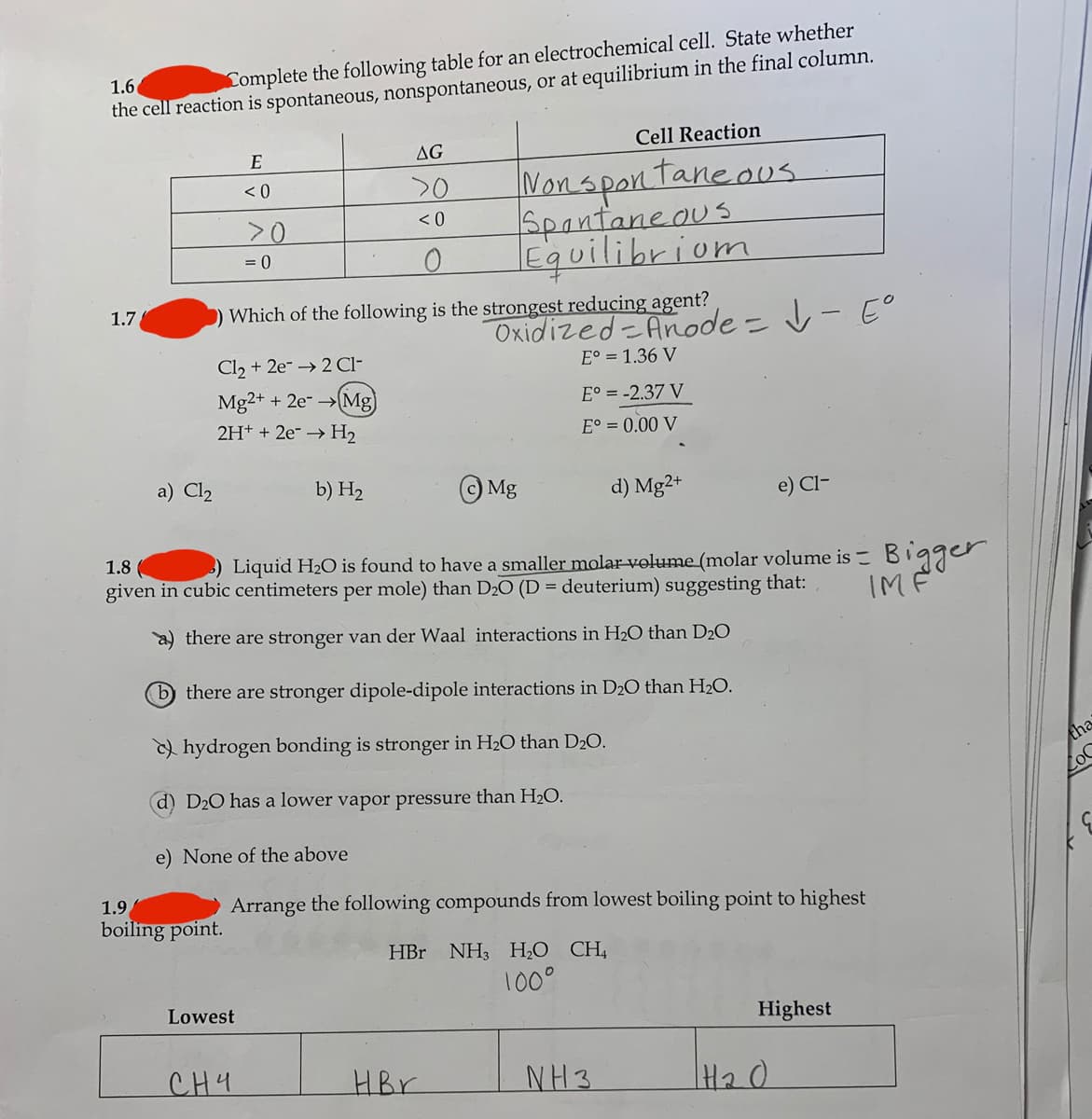1.8 ) Liquid H2O is found to have a smaller molar volume (molar volume is = given in cubic centimeters per mole) than D2O (D = deuterium) suggesting that: IM F a) there are stronger van der Waal interactions in H2O than D2O there are stronger dipole-dipole interactions in D20 than H2O. hydrogen bonding is stronger in H2O than D20. d) D20 has a lower vapor pressure than H2O. e) None of the above 1.9 Arrange the following compounds from lowest boiling point to highest boiling point. HBr NH3 H;O CH, 100° Lowest Highest CH4 HBr NH3 H20
1.8 ) Liquid H2O is found to have a smaller molar volume (molar volume is = given in cubic centimeters per mole) than D2O (D = deuterium) suggesting that: IM F a) there are stronger van der Waal interactions in H2O than D2O there are stronger dipole-dipole interactions in D20 than H2O. hydrogen bonding is stronger in H2O than D20. d) D20 has a lower vapor pressure than H2O. e) None of the above 1.9 Arrange the following compounds from lowest boiling point to highest boiling point. HBr NH3 H;O CH, 100° Lowest Highest CH4 HBr NH3 H20
Chemical Principles in the Laboratory
11th Edition
ISBN:9781305264434
Author:Emil Slowinski, Wayne C. Wolsey, Robert Rossi
Publisher:Emil Slowinski, Wayne C. Wolsey, Robert Rossi
Chapter32: Voltaic Cell Measurements
Section: Chapter Questions
Problem 2ASA
Related questions
Question
1.8,1.9,1.10 please solve ASAP!

Transcribed Image Text:Complete the following table for an electrochemical cell. State whether
the cell reaction is spontaneous, nonspontaneous, or at equilibrium in the final column.
1.6
E
AG
Cell Reaction
Nonspantane.ous.
Spantaneous
equilibriom
<0
20
>0
< 0
= 0
1.7
Which of the following is the strongest reducing agent?
Oxidized-Anode = v- E°
E° = 1.36 V
%3D
Cl, + 2e- → 2 Cl-
Mg2+ + 2e- Mg
E° = -2.37 V
2H+ + 2e- → H2
E° = 0.00 V
a) Cl2
b) H2
Mg
d) Mg2+
e) Cl-
1.8
) Liquid H2O is found to have a smaller molar volume (molar volume is Bigger
given in cubic centimeters per mole) than D2O (D = deuterium) suggesting that:
IMF
2) there are stronger van der Waal interactions in H2O than D2O
b there are stronger dipole-dipole interactions in D20 than H2O.
) hydrogen bonding is stronger in H2O than D20.
tha
d) D20 has a lower vapor pressure than H2O.
LoC
e) None of the above
boiling point.
1.9
Arrange the following compounds from lowest boiling point to highest
HBr NH3 H2O CH,
100°
Lowest
Highest
CH4
HBr
NH3
Expert Solution
This question has been solved!
Explore an expertly crafted, step-by-step solution for a thorough understanding of key concepts.
Step by step
Solved in 3 steps

Knowledge Booster
Learn more about
Need a deep-dive on the concept behind this application? Look no further. Learn more about this topic, chemistry and related others by exploring similar questions and additional content below.Recommended textbooks for you

Chemical Principles in the Laboratory
Chemistry
ISBN:
9781305264434
Author:
Emil Slowinski, Wayne C. Wolsey, Robert Rossi
Publisher:
Brooks Cole

Chemistry: Principles and Reactions
Chemistry
ISBN:
9781305079373
Author:
William L. Masterton, Cecile N. Hurley
Publisher:
Cengage Learning

Chemistry: Principles and Practice
Chemistry
ISBN:
9780534420123
Author:
Daniel L. Reger, Scott R. Goode, David W. Ball, Edward Mercer
Publisher:
Cengage Learning

Chemical Principles in the Laboratory
Chemistry
ISBN:
9781305264434
Author:
Emil Slowinski, Wayne C. Wolsey, Robert Rossi
Publisher:
Brooks Cole

Chemistry: Principles and Reactions
Chemistry
ISBN:
9781305079373
Author:
William L. Masterton, Cecile N. Hurley
Publisher:
Cengage Learning

Chemistry: Principles and Practice
Chemistry
ISBN:
9780534420123
Author:
Daniel L. Reger, Scott R. Goode, David W. Ball, Edward Mercer
Publisher:
Cengage Learning

Principles of Modern Chemistry
Chemistry
ISBN:
9781305079113
Author:
David W. Oxtoby, H. Pat Gillis, Laurie J. Butler
Publisher:
Cengage Learning

Chemistry: An Atoms First Approach
Chemistry
ISBN:
9781305079243
Author:
Steven S. Zumdahl, Susan A. Zumdahl
Publisher:
Cengage Learning
